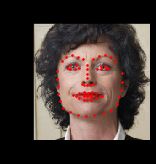使用pytorch 的torch.utils.Dataset类编写自己的数据集类
目录
- 导入必要的库
- 用pandas读入数据
- 定义一个显示图片和landmarks的函数
- 定义一个Dataset类, 继承torch.utils.Dataset类
- 自定义图像的变换
- 图像缩放
- 随机裁剪
- 将numpy的ndarrays转换为 Tensor
- 将transform组合
- 使用Dataloader遍历自定义的dataset
导入必要的库
from __future__ import print_function, division
import os
import torch
import pandas as pd
from skimage import io, transform
import numpy as np
import matplotlib.pyplot as plt
from torch.utils.data import Dataset, DataLoader
from torchvision import transforms, utils
# ignore warnings
import warnings
warnings.filterwarnings("ignore")
plt.ion()
用pandas读入数据
landmarks_frame = pd.read_csv(r'../data/faces/face_landmarks.csv')
n = 65
img_name = landmarks_frame.iloc[n, 0]
landmarks = landmarks_frame.iloc[n, 1:].as_matrix()
landmarks = landmarks.astype('float').reshape(-1, 2)
print('Image name: {}'.format(img_name))
print('Landmarks shape: {}'.format(landmarks.shape))
print('First 4 landmarks: {}'.format(landmarks[:4]))
Image name: person-7.jpg
Landmarks shape: (68, 2)
First 4 landmarks: [[32. 65.]
[33. 76.]
[34. 86.]
[34. 97.]]
定义一个显示图片和landmarks的函数
# 显示图片和landmarks的函数
def show_landmarks(image, landmarks):
""" show image with landmarks"""
plt.imshow(image)
plt.scatter(landmarks[:, 0], landmarks[:, 1], s=10, marker='.', c='r')
plt.pause(0.001)
plt.figure()
show_landmarks(io.imread(os.path.join('../data/faces', img_name)), landmarks)
plt.show()
定义一个Dataset类, 继承torch.utils.Dataset类
torch.utils.data.Dataset 是一个抽象类, 表示一个dataset.
自定义的dataset类需要继承Dataset. 并且重载:
- __len__函数, len(dataset)返回数据集的长度
- __getitem__函数, 支持dataset[i]寻址.
class FaceLandmarksDataset(Dataset):
"""Face Landmarks dataset."""
def __init__(self, csv_file, root_dir, transform=None):
"""
:param csv_file: csv文件的路径
:param root_dir: 图像的文件夹路径
:param transform: 可选的transform
"""
self.landmarks_frame = pd.read_csv(csv_file)
self.root_dir = root_dir
self.transform = transform
def __len__(self):
return len(self.landmarks_frame)
def __getitem__(self, idx):
if torch.is_tensor(idx):
idx = idx.tolist()
img_name = os.path.join(self.root_dir, self.landmarks_frame.iloc[idx, 0])
image = io.imread(img_name)
landmarks = self.landmarks_frame.iloc[idx, 1:]
landmarks = np.array([landmarks])
landmarks = landmarks.astype('float').reshape(-1, 2)
sample = {'image': image, 'landmarks': landmarks}
if self.transform:
sample = self.transform(sample)
return sample
# 初始化此类
face_dataset = FaceLandmarksDataset(csv_file=r'../data/faces/face_landmarks.csv',
root_dir='../data/faces/')
# 绘制前4个图.
fig = plt.figure()
for i in range(len(face_dataset)):
sample = face_dataset[i]
print(i, sample['image'].shape, sample['landmarks'].shape)
ax = plt.subplot(1, 4, i+1)
plt.tight_layout()
ax.set_title('Sample #{}'.format(i))
ax.axis('off')
show_landmarks(**sample)
if i == 3:
plt.show()
break
0 (324, 215, 3) (68, 2)
1 (500, 333, 3) (68, 2)
2 (250, 258, 3) (68, 2)
3 (434, 290, 3) (68, 2)
自定义图像的变换
图像缩放
#%%
# 自定义transforms
class Rescale(object):
"""图像缩放"""
def __init__(self, output_size):
assert isinstance(output_size, (int, tuple))
self.output_size = output_size
def __call__(self, sample):
image, landmarks = sample['image'], sample['landmarks']
h, w = image.shape[:2]
if isinstance(self.output_size, int):
# 如果目标尺寸只有一个值, 那么按照最小边缩放到此值.
if h > w:
new_h, new_w = self.output_size * h / w, self.output_size
else:
new_h, new_w = self.output_size, self.output_size * w / h
else:
new_h, new_w = self.output_size
new_h, new_w = int(new_h), int(new_w)
img = transform.resize(image, (new_h, new_w))
# 对landmarks做缩放变换. landmarks的x值是横坐标, y是纵坐标.
landmarks = landmarks * [new_w / w, new_h / h]
return {'image': img, 'landmarks': landmarks}
随机裁剪
#%%
class RandomCrop(object):
"""随机裁剪"""
def __init__(self, output_size):
assert isinstance(output_size, (int, tuple))
if isinstance(output_size, int):
self.output_size = (output_size, output_size)
else:
assert len(output_size) == 2
self.output_size = output_size
def __call__(self, sample):
image, landmarks = sample['image'], sample['landmarks']
h, w = image.shape[:2]
new_h, new_w = self.output_size
top = np.random.randint(0, h - new_h)
left = np.random.randint(0, w - new_w)
image = image[top: top + new_h, left: left + new_w]
# 注意landmarks裁剪后可能是负值
landmarks = landmarks - [left, top]
return {'image': image, 'landmarks': landmarks}
将numpy的ndarrays转换为 Tensor
class ToTensor(object):
"""将numpy的ndarrays转换为 Tensor"""
def __call__(self, sample):
image, landmarks = sample['image'], sample['landmarks']
# 将矩阵转换为 channel * height * width
image = image.transpose((2, 0, 1))
return {'image': torch.from_numpy(image),
'landmarks': torch.from_numpy(landmarks)}
将transform组合
# 将transform组合
scale = Rescale(256)
crop = RandomCrop(128)
composed = transforms.Compose([Rescale(256),
RandomCrop(224)])
fig = plt.figure()
sample = face_dataset[65]
print(type(sample))
for i, tsfrm in enumerate([scale, crop, composed]):
transformed_sample = tsfrm(sample)
ax = plt.subplot(1, 3, i+1)
plt.tight_layout()
ax.set_title(type(tsfrm).__name__)
show_landmarks(**transformed_sample)
plt.show()
使用Dataloader遍历自定义的dataset
# 遍历dataset
transfromed_dataset = FaceLandmarksDataset(csv_file='../data/faces/face_landmarks.csv',
root_dir='../data/faces/',
transform=transforms.Compose([
Rescale(256),
RandomCrop(224),
ToTensor()
]))
for i in range(len(transfromed_dataset)):
sample = transfromed_dataset[i]
print(i, sample['image'].size(), sample['landmarks'].size())
if i == 3:
break
# BrokenPipeError,则将num_workers 设置为0.
dataloader = DataLoader(transfromed_dataset, batch_size=4,
shuffle=True, num_workers=0)
# 显示一个batch的函数
def show_landmarks_batch(sample_batched):
"""show image with landmarks for a batch of samples"""
images_batch, landmarks_batch = sample_batched['image'], sample_batched['landmarks']
batch_size = len(images_batch)
im_size = images_batch.size(2)
grid_border_size = 2
grid = utils.make_grid(images_batch)
plt.imshow(grid.numpy().transpose((1, 2, 0)))
for i in range(batch_size):
plt.scatter(landmarks_batch[i,:,0].numpy() + i*im_size +(i+1)*grid_border_size,
landmarks_batch[i,:,1].numpy() + grid_border_size,
s = 10, marker='.', c='r')
plt.title('Batch from dataloader')
for i_batch, sample_batched in enumerate(dataloader):
print(i_batch, sample_batched['image'].size(),
sample_batched['landmarks'].size())
if i_batch == 3:
plt.figure()
show_landmarks_batch(sample_batched)
plt.axis('off')
plt.ioff()
plt.show()
break
0 torch.Size([3, 224, 224]) torch.Size([68, 2])
1 torch.Size([3, 224, 224]) torch.Size([68, 2])
2 torch.Size([3, 224, 224]) torch.Size([68, 2])
3 torch.Size([3, 224, 224]) torch.Size([68, 2])
0 torch.Size([4, 3, 224, 224]) torch.Size([4, 68, 2])
1 torch.Size([4, 3, 224, 224]) torch.Size([4, 68, 2])
2 torch.Size([4, 3, 224, 224]) torch.Size([4, 68, 2])
3 torch.Size([4, 3, 224, 224]) torch.Size([4, 68, 2])








